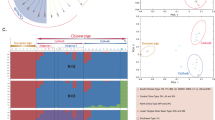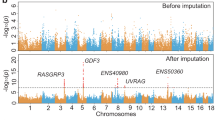Abstract
Domestic pigs have evolved genetic adaptations to their local environmental conditions, such as cold and hot climates. We sequenced the genomes of 69 pigs from 15 geographically divergent locations in China and detected 41 million variants, of which 21 million were absent from the dbSNP database. In a genome-wide scan, we identified a set of loci that likely have a role in regional adaptations to high- and low-latitude environments within China. Intriguingly, we found an exceptionally large (14-Mb) region with a low recombination rate on the X chromosome that appears to have two distinct haplotypes in the high- and low-latitude populations, possibly underlying their adaptation to cold and hot environments, respectively. Surprisingly, the adaptive sweep in the high-latitude regions has acted on DNA that might have been introgressed from an extinct Sus species. Our findings provide new insights into the evolutionary history of pigs and the role of introgression in adaptation.
This is a preview of subscription content, access via your institution
Access options
Subscribe to this journal
Receive 12 print issues and online access
$209.00 per year
only $17.42 per issue
Buy this article
- Purchase on Springer Link
- Instant access to full article PDF
Prices may be subject to local taxes which are calculated during checkout





Similar content being viewed by others
Accession codes
References
Larson, G. et al. Worldwide phylogeography of wild boar reveals multiple centers of pig domestication. Science 307, 1618–1621 (2005).
Larson, G. et al. Patterns of East Asian pig domestication, migration, and turnover revealed by modern and ancient DNA. Proc. Natl. Acad. Sci. USA 107, 7686–7691 (2010).
Wang, L. et al. in Animal Genetic Resources in China: Pigs (ed. China National Commission of Animal Genetic Resources) 2–16 (China Agricultural Press, 2011).
Nachman, M.W., Hoekstra, H.E. & D'Agostino, S.L. The genetic basis of adaptive melanism in pocket mice. Proc. Natl. Acad. Sci. USA 100, 5268–5273 (2003).
Bersaglieri, T. et al. Genetic signatures of strong recent positive selection at the lactase gene. Am. J. Hum. Genet. 74, 1111–1120 (2004).
Lamason, R.L. et al. SLC24A5, a putative cation exchanger, affects pigmentation in zebrafish and humans. Science 310, 1782–1786 (2005).
Jones, F.C. et al. The genomic basis of adaptive evolution in threespine sticklebacks. Nature 484, 55–61 (2012).
Kamberov, Y.G. et al. Modeling recent human evolution in mice by expression of a selected EDAR variant. Cell 152, 691–702 (2013).
Rubin, C.J. et al. Whole-genome resequencing reveals loci under selection during chicken domestication. Nature 464, 587–591 (2010).
Atanur, S.S. et al. Genome sequencing reveals loci under artificial selection that underlie disease phenotypes in the laboratory rat. Cell 154, 691–703 (2013).
Axelsson, E. et al. The genomic signature of dog domestication reveals adaptation to a starch-rich diet. Nature 495, 360–364 (2013).
Shapiro, M.D. et al. Genomic diversity and evolution of the head crest in the rock pigeon. Science 339, 1063–1067 (2013).
Groenen, M.A. et al. Analyses of pig genomes provide insight into porcine demography and evolution. Nature 491, 393–398 (2012).
Rubin, C.J. et al. Strong signatures of selection in the domestic pig genome. Proc. Natl. Acad. Sci. USA 109, 19529–19536 (2012).
Li, M. et al. Genomic analyses identify distinct patterns of selection in domesticated pigs and Tibetan wild boars. Nat. Genet. 45, 1431–1438 (2013).
Fang, X. et al. The sequence and analysis of a Chinese pig genome. Gigascience 1, 16 (2012).
Bosse, M. et al. Regions of homozygosity in the porcine genome: consequence of demography and the recombination landscape. PLoS Genet. 8, e1003100 (2012).
Tortereau, F. et al. A high density recombination map of the pig reveals a correlation between sex-specific recombination and GC content. BMC Genomics 13, 586 (2012).
Cornforth, M.N. & Eberle, R.L. Termini of human chromosomes display elevated rates of mitotic recombination. Mutagenesis 16, 85–89 (2001).
Muotri, A.R., Marchetto, M.C., Coufal, N.G. & Gage, F.H. The necessary junk: new functions for transposable elements. Hum. Mol. Genet. 16 Spec. No. 2, R159–R167 (2007).
Boulant, J.A. & Dean, J.B. Temperature receptors in the central nervous system. Annu. Rev. Physiol. 48, 639–654 (1986).
Adolph, E.F. & Molnar, G.W. Exchanges of heat and tolerances to cold in men exposed to outdoor weather. Am. J. Physiol. 146, 507–537 (1946).
Chaffee, R.R. et al. Comparative chemical thermoregulation in cold- and heat-acclimated rodents, insectivores, protoprimates, and primates. Fed. Proc. 28, 1029–1034 (1969).
Stocks, J.M., Taylor, N.A., Tipton, M.J. & Greenleaf, J.E. Human physiological responses to cold exposure. Aviat. Space Environ. Med. 75, 444–457 (2004).
Jansky, L. & Hart, J.S. Cardiac output and organ blood flow in warm- and cold-acclimated rats exposed to cold. Can. J. Physiol. Pharmacol. 46, 653–659 (1968).
Alazami, A.M. et al. Mutations in C2orf37, encoding a nucleolar protein, cause hypogonadism, alopecia, diabetes mellitus, mental retardation, and extrapyramidal syndrome. Am. J. Hum. Genet. 83, 684–691 (2008).
Schmidt, E.M. et al. Chorein sensitivity of cytoskeletal organization and degranulation of platelets. FASEB J. 27, 2799–2806 (2013).
Keatinge, W.R. et al. Increased platelet and red cell counts, blood viscosity, and plasma cholesterol levels during heat stress, and mortality from coronary and cerebral thrombosis. Am. J. Med. 81, 795–800 (1986).
Ma, J. et al. Recombinational landscape of porcine X chromosome and individual variation in female meiotic recombination associated with haplotypes of Chinese pigs. BMC Genomics 11, 159 (2010).
Nachman, M.W. Single nucleotide polymorphisms and recombination rate in humans. Trends Genet. 17, 481–485 (2001).
Choo, K.H. Why is the centromere so cold? Genome Res. 8, 81–82 (1998).
Kong, A. et al. A high-resolution recombination map of the human genome. Nat. Genet. 31, 241–247 (2002).
Hewitt, G. The genetic legacy of the Quaternary ice ages. Nature 405, 907–913 (2000).
Frantz, L.A. et al. Genome sequencing reveals fine scale diversification and reticulation history during speciation in Sus. Genome Biol. 14, R107 (2013).
Ai, H. et al. Inference of population history and genome-wide detection of signatures for high-altitude adaptation in Tibetan pigs. BMC Genomics 15, 834 (2014).
Li, H. & Durbin, R. Fast and accurate short read alignment with Burrows-Wheeler transform. Bioinformatics 25, 1754–1760 (2009).
Li, R. et al. SNP detection for massively parallel whole-genome resequencing. Genome Res. 19, 1124–1132 (2009).
McKenna, A. et al. The Genome Analysis Toolkit: a MapReduce framework for analyzing next-generation DNA sequencing data. Genome Res. 20, 1297–1303 (2010).
Li, H. et al. The Sequence Alignment/Map format and SAMtools. Bioinformatics 25, 2078–2079 (2009).
Wang, J. et al. CREST maps somatic structural variation in cancer genomes with base-pair resolution. Nat. Methods 8, 652–654 (2011).
Tamura, K. et al. MEGA5: molecular evolutionary genetics analysis using maximum likelihood, evolutionary distance, and maximum parsimony methods. Mol. Biol. Evol. 28, 2731–2739 (2011).
Purcell, S. et al. PLINK: a tool set for whole-genome association and population-based linkage analyses. Am. J. Hum. Genet. 81, 559–575 (2007).
Shriver, M.D. et al. The genomic distribution of population substructure in four populations using 8,525 autosomal SNPs. Hum. Genomics 1, 274–286 (2004).
Reich, D., Thangaraj, K., Patterson, N., Price, A.L. & Singh, L. Reconstructing Indian population history. Nature 461, 489–494 (2009).
Carneiro, M. et al. Rabbit genome analysis reveals a polygenic basis for phenotypic change during domestication. Science 345, 1074–1079 (2014).
Delaneau, O., Marchini, J. & Zagury, J.F. A linear complexity phasing method for thousands of genomes. Nat. Methods 9, 179–181 (2012).
Bindea, G. et al. ClueGO: a Cytoscape plug-in to decipher functionally grouped gene ontology and pathway annotation networks. Bioinformatics 25, 1091–1093 (2009).
Fan, Y. et al. A further look at porcine chromosome 7 reveals VRTN variants associated with vertebral number in Chinese and Western pigs. PLoS ONE 8, e62534 (2013).
Druet, T. & Georges, M. A hidden Markov model combining linkage and linkage disequilibrium information for haplotype reconstruction and quantitative trait locus fine mapping. Genetics 184, 789–798 (2010).
Thomson, R., Pritchard, J.K., Shen, P., Oefner, P.J. & Feldman, M.W. Recent common ancestry of human Y chromosomes: evidence from DNA sequence data. Proc. Natl. Acad. Sci. USA 97, 7360–7365 (2000).
Acknowledgements
We thank L. Andersson for critical discussions and reading of the manuscript. This study is supported by the National Key Research Project of China (2013ZX08006-5), the Natural Science Foundation of China (31230069) and the Changjiang Scholars and Innovative Research Team in University (IRT1136).
Author information
Authors and Affiliations
Contributions
L. Huang and J.R. designed the study and analyzed the data. J.R., B.Y., H.A., X.F., R.N. and L. Huang wrote the manuscript. H.A., X.F., B.Y., Z.H., H.C., L.M., F.Z., L. Zhang, L.C., W.H., T.H., W.D. and R.N. performed bioinformatics analyses. J.Y., X.Y., L. Zhou, L. Han, J.L., S.S., X.X., B.L., Y.S., Y.L. and H.Y. collected data and performed sequencing and genotyping experiments.
Corresponding authors
Ethics declarations
Competing interests
The authors declare no competing financial interests.
Supplementary information
Supplementary Text and Figures
Supplementary Figures 1–19, Supplementary Tables 1–10 and 14–22, and Supplementary Note. (PDF 4973 kb)
Supplementary Tables 11–13
Supplementary Tables 11–13. (XLS 157 kb)
Rights and permissions
About this article
Cite this article
Ai, H., Fang, X., Yang, B. et al. Adaptation and possible ancient interspecies introgression in pigs identified by whole-genome sequencing. Nat Genet 47, 217–225 (2015). https://doi.org/10.1038/ng.3199
Received:
Accepted:
Published:
Issue Date:
DOI: https://doi.org/10.1038/ng.3199
This article is cited by
-
Genetic introgression from commercial European pigs to the indigenous Chinese Lijiang breed and associated changes in phenotypes
Genetics Selection Evolution (2024)
-
Genome-wide detection of selection signatures in Jianli pigs reveals novel cis-regulatory haplotype in EDNRB associated with two-end black coat color
BMC Genomics (2024)
-
Genomic evidence for human-mediated introgressive hybridization and selection in the developed breed
BMC Genomics (2024)
-
Whole-genome resequencing of Chinese indigenous sheep provides insight into the genetic basis underlying climate adaptation
Genetics Selection Evolution (2024)
-
Population genetics reveals new introgression in the nucleus herd of min pigs
Genes & Genomics (2024)



